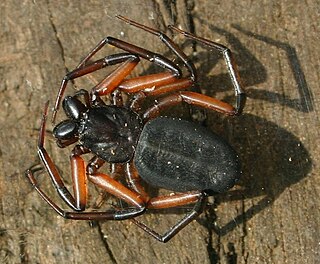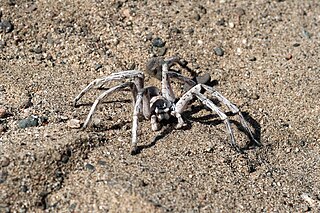
Huntsman spiders, members of the family Sparassidae, are known by this name because of their speed and mode of hunting. They are also called giant crab spiders because of their size and appearance. Larger species sometimes are referred to as wood spiders, because of their preference for woody places. In southern Africa the genus Palystes are known as rain spiders or lizard-eating spiders. Commonly, they are confused with baboon spiders from the Mygalomorphae infraorder, which are not closely related.

Mexcala is a genus of jumping spiders that was first described by George and Elizabeth Peckham in 1902. The name is probably derived from the Nahuatl mezcal.
Diploglena is a genus of African araneomorph spiders in the family Caponiidae, first described by William Frederick Purcell in 1904.

Leucorchestris is a genus of African huntsman spiders that was first described in 1962 by R. F. Lawrence, who described all of the species in the genus between 1962 and 1966.

Platyoides is a genus of spiders belonging to the family Trochanteriidae. Its members are known as scorpion spiders and are found in sub-Saharan Africa and its islands, Madagascar, Réunion, Aldabra and the Canary Islands.

Idiops is a genus of armored trapdoor spiders that was first described by Josef Anton Maximilian Perty in 1833. It is the type genus of the spurred trapdoor spiders, Idiopidae. Idiops is also the most species-rich genus of the family, and is found at widely separated locations in the Neotropics, Afrotropics, Indomalaya and the Middle East. Females live in tubular burrows lined with a thick layer of white silk. These typically have a D-shaped lid that fits into the entrance like a cork, and some burrows have two entrances. The lid may consist of mud, moss or lichen, which is bound below by a thick layer of silk. As in all genera of this family, the anterior lateral eyes (ALE) are situated near the clypeal margin, far in front of the remaining six eyes, which are arranged in a tight group. The males which are smaller in size, wander about or occasionally live in burrows. Like other mygalomorphs, they are relatively large and long-lived. Forest clearance and agricultural practices that loosen the soil and enhance erosion, besides soil removal for brick making have been pointed out as serious threats to some Indian species. Species ranges are poorly known – in India for instance, most species are known only from their type localities.
Reginald Frederick Lawrence FRSSAf was a South African arachnologist and myriapodologist at the South African Museum in Cape Town from 1922 until 1935, director of the Natal Museum in Pietermaritzburg from 1935 until 1948 and a researcher and staff member of the same museum until 1986.

Dresserus is a genus of African velvet spiders that was first described by Eugène Simon in 1876.

Paradonea is a genus of African velvet spiders that was first described by R. F. Lawrence in 1968.
Austrachelas is a genus of African long-jawed ground spiders in the family Gallieniellidae, and was first described by R. F. Lawrence in 1938. Originally placed with the corinnid sac spiders, it was moved to the Gallieniellidae in 2009.
Tyrotama is a genus of African tree trunk spiders that was first described by S. H. Foord & A. S. Dippenaar-Schoeman in 2005.
Arandisa is a monotypic genus of Namibian huntsman spiders containing the single species, Arandisa deserticola. It was first described by R. F. Lawrence in 1938, and is found in Namibia.

Orchestrella is a genus of Namibian huntsman spiders that was first described by R. F. Lawrence in 1965. As of September 2019 it contains two species, found in Namibia: O. caroli and O. longipes.
Asemesthes is a genus of African ground spiders that was first described by Eugène Simon in 1887.
Ibala is a genus of African ground spiders that was first described by M. J. FitzPatrick in 2009.
Trephopoda is a genus of southern African ground spiders first described by R. W. E. Tucker in 1923. They have only been found in Namibia and South Africa.
Trichothyse is a genus of African ground spiders that was first described by R. W. E. Tucker in 1923.
Theuma is a genus of African long-spinneret ground spiders that was first described by Eugène Louis Simon in 1893.It was transferred to the ground spiders in 2018, then returned in 2022.

Hexophthalma is a genus of spiders in the family Sicariidae. Although the genus was originally erected in 1878, it was merged into the genus Sicarius in the 1890s, and remained unused until revived in 2017, when it was discovered that the African species then placed in Sicarius were distinct. The English name six-eyed sand spiders is used for members of the genus, particularly Hexophthalma hahni. Species in the genus have necrotic (dermonecrotic) venom, and can potentially cause serious or even life-threatening wounds.
Ikuma is a genus of Namibian palp-footed spiders that was first described by R. F. Lawrence in 1938. As of June 2019 it contains only two species, found only in Namibia: I. spiculosa and I. squamata.









